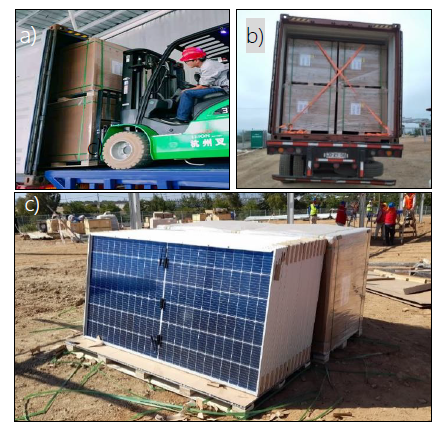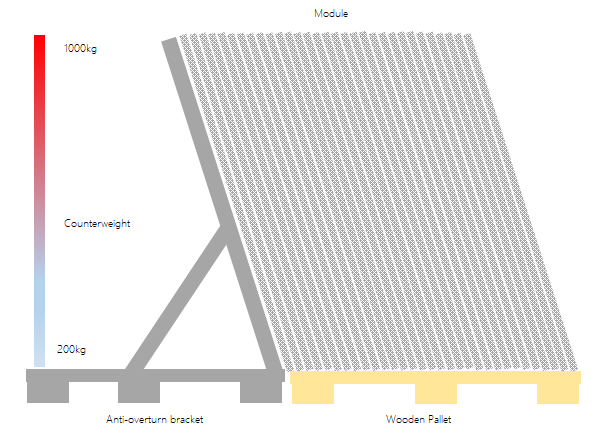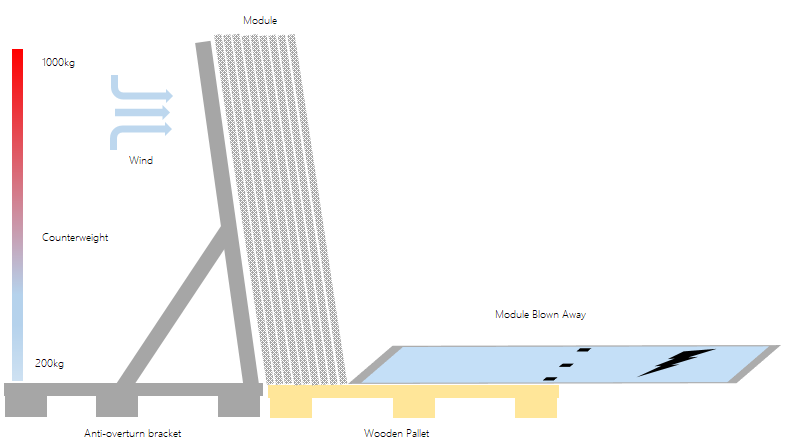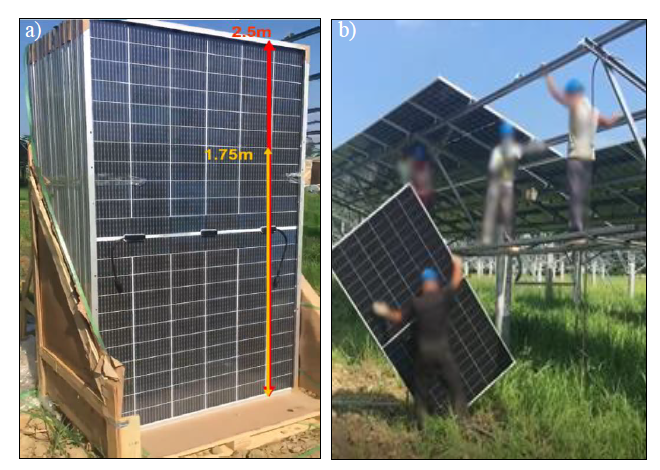China is widelyrecognized as the centre of the world’s PV module manufacturing, shipping toevery corner of the globe via sea, road, rail and air. With factors such asdelivery cycle, capacity and cost to be considered, sea transportation hasbecome the preferred mode for shipping and, with this being the case, how tomaximize utilization of container capacity is now a key area of focus fordesign engineers.
I. Packaging Methods for PV Modules

Figure 1. Three packaging methods forPV modules: a) Landscape vertical packaging is recognized as optimal; b)Horizontal stacking has been eliminated; c) Portrait vertical packaging isapplied for larger PV modules.
Vertical packing is commonly viewed asthe optimal method, coming about from issues with the horizontal stacking alternative.Upright packaging resolves the three key problems with horizontal stacking, namelymodule frame deformation, glass breakage and invisible cracks caused in transitand the landscape vertical solution has become the common choice over theportrait alternative.
II. Maximum Permitted Size with Landscape Vertical Packaging
Satisfying the ultimate objective of reducingthe ratio of products either broken or with invisible cracks on arrival, landscapevertical packaging has a lower barycenter with the resultant lower risk of modulesoverturning during packing and unpacking, due to its design advantage for operationalsafety performance. This is the key reason for its preferred status, better meetingthe requirements for reliability during sea transportation, the stability ofpackaging and the safety of employees involved.
According to the height of a container door, the maximumpermitted height for optimal packaging can be determined. The logicalrelationship is shown below:

In line with an optimal product width of 1,133 mm and the symmetricalstyle of a module's design aesthetics, LONGi launched its 182 mm×
182 mm wafer-cell and Hi-MO 5 series products, designed specificallyfor the entire industrial chain and to maximize value for customers.

Figure 2. Pictures of PV moduletransportation, loading and unloading placement: a) Hi-MO 5 product is loadedinto the container in the factory, with a forklift operating margin of about 10cm; b) the container is delivered to a project site with uneven ground; c) the landscapevertically packaged modules can be placed stably in different situations.
III. Portrait Vertical Packaging Issues for Large-size PVModules
· Theoperational margin for container loading and unloading isextremely limited, with theoretically only about 7 cm available.
Hi-MO 5 products are designed to present a 10 cm operatingmargin for container loading and unloading. However, this redundancy in operatingheight for larger modules in a portrait vertical packaging scenario is reducedto around 7.0 cm once height, thickness of packing paper and pallet height aretaken into account, meaning that overall height will exceed 2.5m, with that ofthe container door 2.575m. While goods packed tightly can be loaded andunloaded by skilled workers in a factory environment with equipment such as acargo platform, there are no such facilities available at overseas warehousesor project sites.
· Workers are at greater risk of injury from overturningpackages with higher weight and barycenter
Compared with the bifacial Hi-MO 5’s weight of 32.3 kg, theweight of a larger module exceeds 38.7 kg, an increase of almost 20%. Largermodules are also packed via the portrait vertical method, meaning that theheight of the package will exceed 2.5 m (see Figure 5a.). The height of the barycenteris almost doubled compared with the Hi-MO 5, increasing the possibility of overturningand subsequent injury.

Figure3. To prevent overturning of portrait vertical packaging, anti-overturn supportand hundreds of kilograms of counterweight are required, which is difficult to obtainat a project site.
Taking an initial tilt angle of 75° asan example, larger module weight is 38.7 kg, with one pallet of 31 units havingan overall gravity as shown below:
G = 38.7 × 31 × 9.8 ≈11760N
The pressure on the bevel side ofbracket:
F = G ×cos75°≈3043N
The static friction coefficient betweenthe bracket and sand is taken to be 0.4, with its balance relationship with the horizontalforce as follows:
Fmax = (Mbracket ×9.8 + F×cos75° )×0.4 ≥ F×sin75°According to the above, bracket weight needsto reach more than 660 kg in order to retain non-slip status, with use of abracket of this weight at a project using larger modules a challenge during theconstruction and installation phases.
Bracket weight can also be calculated under different tiltangles, with the smaller the angle of unpacking, the higher the risk of bracketslippage.
If an installer is unpacking, modules may also be overturnedby wind reaching the fifth scale when the number to be unpacked is less than 10units and the tilt angle over 85°(e.g., figure 4.) Insummary, larger modules packed in a portrait vertical method are at greatersafety risk, with additional limitations in terms of bracket unpacking at groundmounted PV plants.

Figure 4. Schematic diagram ofunpacking of modules in portrait vertical method, with support bracket againstwind
· The ground mounted PV plant has poor terrainadaptability, lower efficiency in drayage and higher construction andinstallation costs.
During the initial stage ofconstruction of a large-scale ground mounted PV plant, care needs to be takento position packaged modules so as to avoid them overturning, which makesdrayage more difficult on uneven ground. Compared with the per pallet weight ofHi-MO 5 bifacial modules, that of larger modules shows an increase of 20%, resultingin a net weight of over 1.2 tons. For this reason, a forklift or hoistingmachinery with a large load capacity is required for safe drayage, adding tolabour and equipment costs to complete installation within the constructionperiod.
For installation of larger modules,there is also a possibility of lower efficiency and a higher invisible crack rate. As shownin Figure 5b, it can be difficult for workers to handle a larger module, needingto place a corner on the ground, with the additional concern of exceeding therecommended maximum weight of just under 35kg for handling by two people (themaximum weight for handling by one person is 20kg to 25 kg, with thecoefficient for two people 0.666, i.e., 25 × 2 × 0.666 = 33.3 kg (refer to HSL Guide for Weight Limit in ManualHandling)).

Figure 5. Unpacking and installation oflarger modules: a). The packaging height is much higher than the installer; b) Sizeis too large and wide, leading to lower installation efficiency and potentiallyhigher breakage rate.
According to research, the breakagerate of the Hi-MO 5 bifacial module is generally lower compared to that oflarger modules during installation, whereas the invisible crack rate for largermodules increases more than fivefold.
In conclusion, LONGi adheresto the proven reliability of the landscape vertical packaging solution for its Hi-MO5 modules, this both minimizing sea transportation costs and making unpacking andinstallation more convenient for workers onsite.